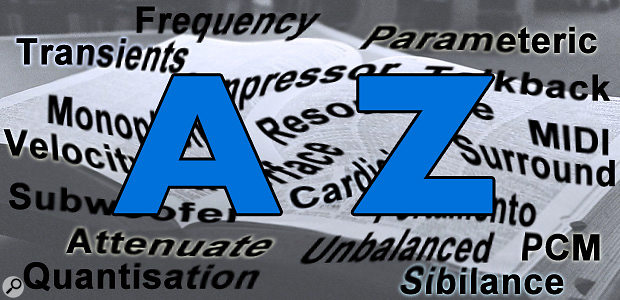You are here
Glossary
Erasable Programmable Read Only Memory. Similar to ROM, but the information on the chip can be erased and replaced using special equipment. (See ROM)
The initial sound reflections from walls, floors and ceilings following a sound created in an acoustically reflective environment.
European Broadcasting Union — a professional organisation that defines equipment standards and practices, amongst other things.
A treatment applied to an audio signal in order to change or enhance it in some creative way. Effects often involve the use of delays, and include such treatments as reverb and echo.
An interface system, usually involving separate send and receive connections, which allows an external signal processor to be connected into the audio chain. (cf. Insert Point)
An additional dedicated mixer input channel, usually with minimal facilities, designed to accommodate the output from an external effects unit. (cf. Aux Return)
A system that modifies a signal prior to recording or transmission, and subsequently restores the signal on playback or reception.
An audio processor designed to brighten audio material using techniques such as dynamic equalisation, phase shifting and harmonic generation.
In a musical context, based on an equal temperament scale, the term enharmonic usually refers to equivalent musical notes which have the same pitch (frequency) but are denoted in different ways. For example, F# is enharmonic with Gb. However, while these two musical notes represent the same pitch, the choice of one or the other denotion would depend on the musical key and/or chord progression of the particular musical work.
An alternative meaning for the term applies where the musical scale is not based on an equal temperament, and thus Ab does not have precisely the same pitch (frequency) as G#. In this case enharmonic refers to notes which are very close in pitch — much closer than a semitone difference — but not absolutely identical.
The way in which the amplitude of a sound signal varies over time.
An electronic circuit capable of generating a control signal which represents the envelope of the sound you want to recreate. This may then be used to control the amplitude of an oscillator or other sound source, though envelopes may also be used to control filter or modulation settings. The most common example is the ADSR generator.
A device which allows the user to adjust the tonality of a sound source by boosting or attenuating specific ranges of frequencies. Equalisers are available in the form of shelf equalisers, parametric equalisers and graphic equalisers — or as a combination of these basic forms. (cf Filter)
A means of describing the intrinsic electronic noise at the output of an amplifier in terms of an equivalent input noise, taking into account the amplifier’s gain.
To remove recorded material from an analogue tape, or to remove digital data from any form of storage media.
A variant of the SATA interface, called eSATA (with the 'e' standing for 'external'), permits the connection of external hard drives -- see SATA.
A control protocol developed by Euphonix which operates at high-speed over an Ethernet connection. It is used between control surfaces and DAW computers to convey information about the positions of faders, knobs, and buttons and to carry display information.
A modular synthesizer format developed by Doepfer in the mid-1990s for its A‑100 system, but which has since become a standard format embraced by most modular synth manufacturers. It uses 3U high panels to accommodate standard Eurocard-size electronics, with 3.5mm plugs for patching and a +/-12V dual-rail power supply (sometimes with a separate 5V rail) connected via a ribbon cable.
In MIDI terms, an event is a single unit of MIDI data, such as a note being turned on or off, a piece of controller information, a program change, and so on.
An audio processor that works by synthesizing new high frequency harmonics.
A hardware or software plug-in device designed to increase the dynamic range, typically by reducing the volume of low level signals (below a set threshold), or to increase the volume of high level signals (above a threshold). (See Compressor.)
A synthesizer with no keyboard, often rack mountable or in some other compact format.

